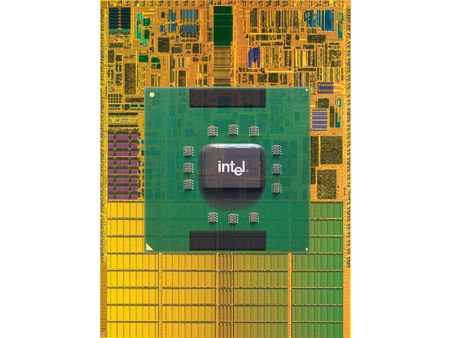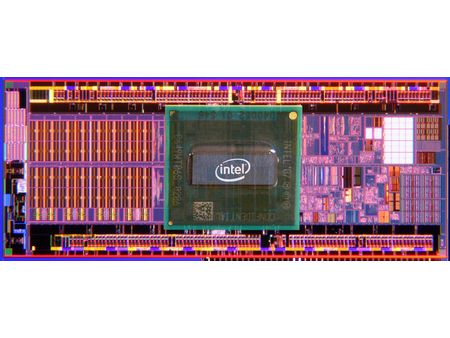Intel Atom CPU Review
Intel and Declining Power Consumption
Power consumption and integrating a processor into portable or embedded devices have always caused problems for Intel, and this is not the first time the company has offered processors aimed at those uses. But the Atom is radically different in that it has a new architecture specially created to reduce power use.
A Short History: Before the Pentium-M
As far back as the 80386, Intel offered versions intended for low power and especially mobile use. The 80386EX, for example, had a chipset built into the CPU and consumed significantly less power than standard 386s. And low-power versions of the 486, the Pentium, and the Pentium II (the Dixon, with its 256 kB of built-in cache) were also offered. And yet in every case they essentially used a very similar (if not identical) architecture to the one used in the desktop version of the processor. In practice, these processors were efficient, but the difference between a standard version and a version for portable PCs remained slight.
The Pentium-M
Released in 2003, the Pentium-M was revolutionary in that it used a different architecture from that of the Pentium 4 and consumed much less power, while maintaining high performance. Yet it was still a derivative of the Pentium III, with the same faults, and the successive improvements to the Pentium-M (leading up to the Core 2 processors) have only increased power consumption. Intel has tried to come out with low-power processors (the A1x0, for example), but essentially they were slowed-down versions of the Pentium-M.
Atom Changes All of That
Atom is a different architecture in the sense that it was designed to reduce power consumption and that the processor uses a totally new design. It isn’t an adaptation of an earlier architecture. Concretely, Intel is now able to offer processors that consume very little power – the high-end Atoms consume less power than the (generally very slow) ULV versions of the standard architectures.
Get Tom's Hardware's best news and in-depth reviews, straight to your inbox.
Current page: Intel and Declining Power Consumption
Prev Page Introduction Next Page Atom Z500 and SCH (Poulsbo)-
joefriday Celerons have significantly lower frequencies than Atom? umm...no. Only the ULV celeron M has a lower freqency. Modern notebooks start with Celerons at least 1.6GHz, more likely 1.86GHz, and are built on the much more modern Merom architecture, which have at least a 10% IPC advantage over the old Dothan architecture. No, atom is nowhere NEAR a modern Celeron in performance. Nice try though.Reply -
joefriday Also, Why not have a Celeron 420 by now? Are you telling me that THG, with all its money, can't budget in a $30 CPU for comparative testing?Reply -
joefriday After reviewing the article, I can say I'm thoroughly unimpressed with the Atom platform (at least the current desktop derivative). If anyone can remember, THG did a $300 PC build using now ancient Celeron Ds and AMD Semprons. One thing that I find amazing, is that those old rigs both use LESS power than this Atom desktop rig.Reply
http://www.tomshardware.com/reviews/the-300-pc,1546-10.html
-
randomizer Don't you people understand that Atom is not a desktop processor? You can't compare its performance to a desktop processor fairly because that's not what it is designed for.Reply -
joefriday This Atom CPU is on a desktop board. That means it's fair game, especially when the processors being compared are also comparable in price.Reply -
randomizer It's on a desktop board, woopdedoo. If you could get your mobile phone processor to run on a desktop board would you compare it to an E2160?Reply -
joefriday Who cares what the Atom CPU is SUPPOSED to be. It is right now, in this review, on a desktop-oriented package, built to compete with low power consumption desktop computers. It fails miserably in that regard, as it is neither low power consumption, nor competitive. In your ridiculous example, if I had a mobile phone processor on a desktop board, and it ended up consuming more power than an E2160/motherboard combo that costs the same amount of money, all the while performing much worse than the e2160, I would call the mobile phone cpu on a desktop motherboard either A FAILURE or AMD. Take your pick.Reply -
apaige So, for the Intel Atom, you do use an updated version of Sandra, but not for the Phenom. You compare it to the VIA C7, a 3 year-old CPU, but not the VIA Nano, which will be available in the same timeframe as the Atom. You don't provide graphics for power consumption, despite the Atom being designed for low power consumption; surprise, the old C7-M system draws less power.Reply
Biased much? -
Not sure that Nano's are really available yet, still a newer mini-itx based C7 (say EPIA-M700) would have been better, since you would be looking at even less power than the one used and the VX800 will end up used with the Nano. The D201DLY would have been good to compare to, would also give some idea how the Atom would go paired with SiS chipsets.Reply


